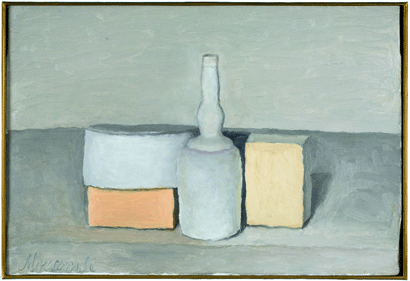Rich in metaphor and genre-busting, Giorgio Morandi’s late work still seems contemporary
There are six paintings, one pencil drawing and one watercolor and pencil drawing in an exhibition of works from the last 15 years of Giorgio Morandi’s life. In “Natura Morta,” (1955), one notices a slight crookedness on the right side of the stretcher. The canvas is stretched over some old, uneven wood with a slight chasm in between it and the edge of the frame of the painting. This might not mean so much in another painter’s work, but one’s observing consciousness always heightens when looking at Morandi.
The surface of the painting is made up of a continuous brushy energy of modulated oil paint. It takes equal possession of the solidity of the objects depicted and of the air surrounding the objects and the waveringly tentative light and shadow. This work has a sensually bumpy bottle at the center of the composition, with the bottle’s neck at the horizon line. On either side of the central object are boxes, a horizontal one in a peach color with a dove gray box above it and, on the other side, a vertical box in a creamy pale yellow.
All of the objects seem to blend and calmly pulsate in this closed, timeless world. But as one walks around the room, the paintings slowly become reachable and very human. The colors, amid the measured warmth or coolness of the grays, possess a curious audacity. This combines with the odd elegance of the arrangements of objects, how they tuck in around one another, behind their proscenium in their shallow spaces and shadows.
Morandi is continually rich in metaphor. From still life, his works travel backward toward some ancient architecture, then move to the present, where they display a sense of stagecraft. They are equally personal and monumental, surreal and bluntly candid. In fact, we gain most from seeing these infinitely quiet little dramas as still contemporary today; they clearly anticipate the kind of genre-busting that contemporary art now displays regularly. To cite one influence this painter had, the late Italian architect Aldo arranged his buildings with Morandi’s bottles in mind.
Near the office of the gallery is one of Morandi’s last paintings, three white objects on a gray ground. A dark red shape, the color of dried blood, hovers behind them. The foreground objects are white, blending from the color of chalk to that of bone. Nature morta indeed.


































